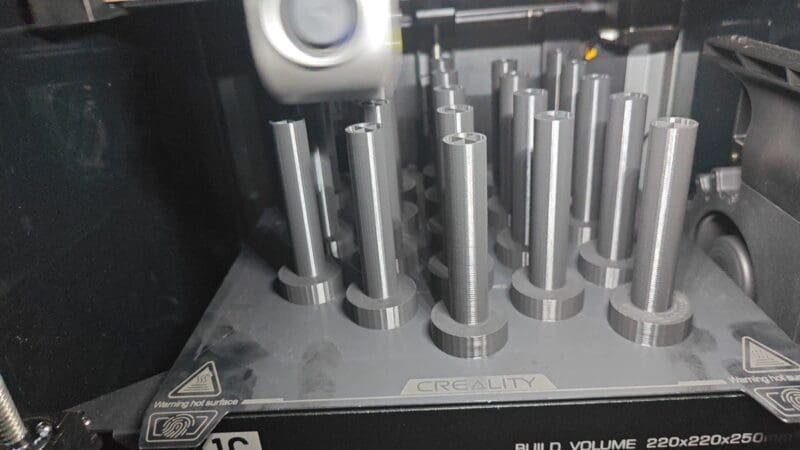What is a Witness Mark And How To Use It?
If you work in the engineering or automotive industries, or if you do your own maintenance, you’ve probably heard the term “witness marking” at some point. Well, in this article, we will try to elucidate what this term exactly means and why you may need to use witness marks!
Besides that, we will also make you aware of some of the best tools you can use to make them.
What is a witness mark?
A witness mark is a scratch or a distinct mark used to precisely position objects apart. That is to say, a mark on each position of an assembly helps determine the previous position of its parts.
Generally, two parts of an assembly each have their own witness marks. Thus when they are lined up, it helps you to ascertain that everything is in the correct position.
On the other hand, there are some people who may be satisfied by considering any physical evidence of how pieces fit together. That means just relying on some impressions or scratches left by the components at the time they were assembled.
Similarly, for some people, discolorations formed over time may also be sufficient and may help them determine the accurate position.
A witness mark, in particular, is a mark that is made intentionally. In fact, this is the precise definition we will try to stick to throughout the rest of this article.
Witness marks are sometimes called match marks, registration marks, or indexing marks as well.
Why use witness marks?

Well, this is surely one classic question and quite an important one to answer. The whole point of using witness marks is to put things back together the way they should be. They are used as a monitoring tool to check if the fastener has loosened over time because of the vibrations.
Accurate Reassembly
When you are reassembling your devices after you get them repaired, witness marks make things easier as you try to fix the components back again.
Usually, it’s quite common for you to make witness marks at the time of disassembling the components of a device. Apart from that, witness marks may be already present on some parts when they were made in the factory.
When you line up all the sets of these match marks on different components, it ensures that everything works and functions as you have intended. After all, this is what prevents you from inserting a component in any wrong orientation or alignment.
It’s crucial to understand that placing components wrongly may create bigger problems for you. That’s indeed where witness marks come in handy and help you a great deal in reassembling a device.
Torque Monitoring
Another situation where witness marks may prove useful is when you deal with bolts or screws that require tightening to a specific torque. Remember that an extra quarter turn of rotation can make a significant difference in certain applications.
However, here you make the witness mark at the time of assembly instead of disassembly. This is done after you have used a torque wrench to tighten the bolt or screw to the correct torque.
- Torque wrench comes with a protective head bumper
- Torque wrench 1/2 inch drive has a locking trigger
- 1/2 torque wrench comes with bi-material grip
- ASME/ISO/TAA Compliant
- Heavy Duty Storage Case
So the next time you check a bolt or screw and discover that the witness mark is not in its proper place, know that you need to correct the torque on that bolt. One primary reason that the fasteners move from their accurate positions is that they loosen up with time. This could also be caused by vibrations, tampering, or parts that have settled after installation. Witness marking is also sometimes called torque striping in this situation.
When should I use witness marks?
It’s imperative to use witness marks when reassembling complex devices, which demand a lot of precision. If we have to enumerate these, there is a long list of such devices.
For example, microscopes, camera lenses, and rifle scopes have some optical elements. Likewise, there are devices with small and minute components such as clocks, watches, lathes, and mills. All these obviously require to be realigned perfectly after maintenance so that they can work properly.
On the contrary, imprecise and uncomplicated items do not necessarily demand witness marking.
But if you are worried about moving anything related to torque monitoring, then you should never overlook witness marking. Witness marking is commonly required for moving engine bolts and nuts, brake systems, clamps, and other components.
Equipment or critical components of mountain bikes, motorcycles, cars, and other machinery also necessitate the use of witness marks at the time of assembling or disassembling.
Besides that, plumbing is another field where witness marking is essential. It is perhaps of great importance when it is about fitting, aligning, and finally gluing the pipes together. Ultimately, it negates the possibility of encountering any alignment problems in the whole process.
How to make a witness mark?
Making a witness mark is quite an easy thing to do. In fact, all you have to do is just make a set of aligned marks on the parts of an assembly that require alignment. At the same time, selecting the best tools for making witness marks is critical.
Thus, picking up a perfect one completely depends on the type of components you are dealing with. Let’s say that if you are working on parts that remain dry and do not witness a lot of abuse, using a Sharpie would suffice.
However, if you feel that your match marks should have more visibility which is quite important for a swift inspection, DYKEM’s Cross-Check Torque Seal is the best choice.
- Highly visible fluorescent color paste that dries to a hard brittle film.
- Meets BOEING Specifications, BMS8-45 Rev: (G) 15-May-2016 Type II
- Mark will be easily broken if parts are tampered with or become loose.
- Provides a convenient visual method for identification of vibratory loosening or tampering on nuts, bolts, fastener and assemblies.
- Easily detect when torque has changed.
If witness marks show a lot of oils, grease, or abrasion, the better thing would be to go for a different option than choosing products that are ink-, paint, or lacquer based. That’s because they usually come off quite easily and do not at all make for a good long-term solution.
Instead of these, go for a discrete scratch or an indent as they will work far better. You can also use a scriber or prick punch as they are wholly capable of leaving permanent marks on any specific material. Another benefit they can provide along with not coming off is that they offer more precision compared to a marker or torque seal.
Conclusion
Call them witness marks or match marks; they are immensely important in both assembly and disassembly work. After all, they provide an incredibly easier way to determine if fasteners and other parts have moved from their exact positions.
On top of that, they also help you to get the components back together as they are supposed to be. If you are working in the automotive industry, plumbing, or engineering field, you are more likely to need witness marking.
It’s not that you’ll have to mark each and every fastener you work on, but doing so is always a wise thing. There are a lot of tools you can choose from to create these much-needed match marks.
To point out, for non-permanent marks, you may use quality markers or the cross-check torque seal. In case you want something more permanent or long-lasting, using a scriber or prick punch is always a better option. For more information, you can get in touch with us so that we can serve you in the best way possible.
DISCLOSURE: THIS POST MAY CONTAIN AFFILIATE LINKS, MEANING I GET A COMMISSION IF you DECIDE TO MAKE A PURCHASE THROUGH MY LINKS, AT NO COST TO YOU. PLEASE READ MY DISCLOSURE FOR MORE INFO.





